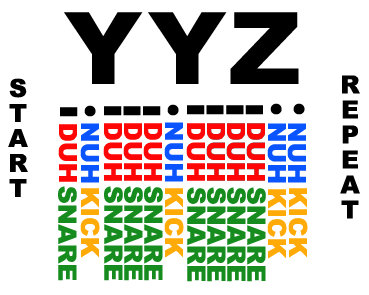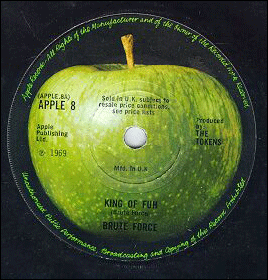While researching hidden code in commercially released music, I ended up turning up tons of references to albums containing morse code. For some reason, this didn’t seem ridiculous enough for me – it seemed too obvious. I’ve since looked into it a bit more and found a few examples that officially surpass my threshold of ridiculousness.
The one really, really great one that I found mention of is in ‘YYZ’ by Rush, from their 1981 album ‘Moving Pictures.’ Now, this is a ridiculous song to begin with – the mind reels at the number of steering wheel percussionists who have caused accidents trying to keep up with Neil Peart’s off-kilter part. It was like an added bonus-burst of ridiculousness to find the hidden meaning in both the title and rhythym of the song.
The rhythm of the beginning of ‘YYZ’ IS the letters ‘YYZ’ in morse code. Just to make sure everyone is clear on what is meant here – this isn’t just someone tapping out the code ‘y y z’ (dash dot dash dash, dash dot dash dash, dash dash dot dot, incidentally) – the actual rhythym of the song follows the code. I’ve illustrated this below using Morse, Drum, and Beavis terminology. I’ve also posted a short clip of the rhythmic intro to the song here.
[audio:yyz.mp3]

About a quarter of the way through they abondon the ‘YYZ’ beat and break into typical Rush fare for a minute or so before hitting a run of prog-ified dancepunk which would make the Rapture piss their pants. It’ll be sampled soon, I hereby declare. But what’s the significance? Why all that trouble to fit ‘YYZ’ into the actual music of the song?
‘YYZ’ is the transmitter code for Toronto’s Lester B. Pearson International Airport. In a 1990 edition of the band’s newsletter, drummer Neil Peart said the song is “loosely based on airport-associated images. Exotic destinations, painful partings, happy landings, that sort of thing.”
Rush, of course, are from Toronto, so this makes sense. Another source adds:
“The characters YYZ are the beacon identifier for the Toronto International Airport. The inspiration for the song came from Alex Lifeson, the guitarist for the band, who holds a private pilots license.”
There’s an essay listing other, less ridiculous instances of Morse code in music here. All songs but ‘YYZ’ appear to be similar instances of low-mixed code played over the song proper. My favorite part of the essay is the conclusion:
“Until next time, KEEP POUNDING BRASS!”
The author mentions a song called ‘(Oh Dear) Miss Morse,’ but fails to deliver on the hidden message:
“Wayne states that in 1967, the band “Pearls Before Swine”
recorded a song with an adult-rated [morse code] message in it. The song was
titled “MISS MORSE”. The song is said to have vulgarities in it spelled
out with Morse Code.
I did a bit of poking around and found out that it’s pretty great. Here are the lyrics to the song:
Oh Dear, Miss Morse,
I want you,
Oh yes, I do,
I want you.This may strike you
Odd-I-ly
But I want you
BodilyDon’t blame me dear,
Blame McLuhan
His media
Was your ruinChorus:
Dit Dit Dah Dit
Dit Dit Dah
Dah Dit Dah Dit
Dah Dit Dah
Examining the chorus, we find that each line is a morse-coded letter. Tom Rapp, the brains behind Pearls Before Swine, had this to say about the song:
“I had read ‘Understanding Media: The Extensions of Man‘ by Marshall McLuhan. I think one of the songs around that time was `Winchester Cathedral’ and we wanted a little vaudeville type song like that. We wanted the chorus to be a rhythmic chorus based on Morse Code.”
“I looked up the word `love’ but it didn’t work. But DIT DIT DAH DIT, DIT DIT DAH, DAH DIT DAH DIT, DAH DIT DAH worked rhythmically, even though it spelled `Fuck,’ of course. Remember (New York DJ) Murray the K? He got into a bit of trouble because he played `(Oh Dear) Miss Morse’ on the radio. Well, who knows Morse Code (especially in 1967)? Boy Scouts and Boy Scout Masters. They all wrote in and said; Do you know what that says!?”
Tangentially: Other creative methods of hiding the word ‘Fuck’ in popular music include the phrase ‘If You See Kay,’ employed by the likes of April WIne, The Poster Children, Memphis Slim, and many others; and the immortal single by Brute Force, ‘The King of Fuh:’
“Brute Force was the guy who sold the Beatles on the idea of releasing his song: ‘The King of Fuh,’ on Apple. Said Derek Taylor: George had met him somewhere, and Brute had written a dificult song called The King Of Fuh. I gave Mr. and Mrs. Force something to drink while we listened to this amazingly rude song about the ‘Fuh King’ who did this and the ‘Fuh King’ who did that, wondering how we would ever get EMI to relase such a work. They didn’t, in fact, but Apple pressed it privately; it was available only through mail-order, and copies now retail for over 350 pounds.”
There’s an mp3 clip of the song on Brute Force’s official site.

As with any good hidden-message technique in the world of music, there are morse code messages falsely attributed to the Beatles. This newsgroup thread details the propigation of the rumor that Lennon hid his initials in ‘Strawberry Fields Forever’ via morse code:
“The source was J. P. Russell in “The Beatles On Record” (Scribner’s,
1982), p. 84. Russell describes two “oddities” about “Strawberry
Fields Forever, one of which “is a Morse code message, tapped out
just after John sings ‘Let me take you down…’. The Morse message
consists of two letters, J and L….”“Mr. Russell clearly does not adequately read morse code. There is
no deliberate “j” ( . – – – ) or “l” ( . – . . ) at all. Instead
there are some electronic pips which several amateur radio enthusiasts
(our own Bob Clements among them) have read as:”-.- .- -.- – – . .-
“where the last dash is considerably extended and there is too
long a space between the first dash and the first dot. This
translates as “KAKTTEA” if you believe it’s Morse. If you misread
the spacing, you can pick out a “j” but there’s just no “l”. Trust
me. I have a Ham license too. :-)”“This actually appears to be “intermodulation distortion”, as
our Mr. Clements describes it, perhaps from the Mellotron used in
this song or from something on the surface of the Mellotron. The
dits and dahs don’t appear to be deliberate, hence the gibberish
when translated. BTW, Mr. Clements used several outtakes of the song
for his analysis as well as Lewisohn, whose studio investigations
reveal no sign of code generators being used as musical accompaniment
to “SFF”, nor any verbal chatter about embedding morse code messages
in the song.”“Russell’s analysis was in error. It’s unfortunate that his book
continues to give rise to such speculation.”
Two more quick links:
- There’s a giant listing titled ‘Morse Goes to the movies‘ for all you morse code lovers out there in INTERNETLAND!
- Finally, the Rhythym of the Code is an amazing bit of audio that is intended to teach Morse Code. Harmonized morse code is the best – listen here.
Until next time, KEEP POUNDING BRASS!